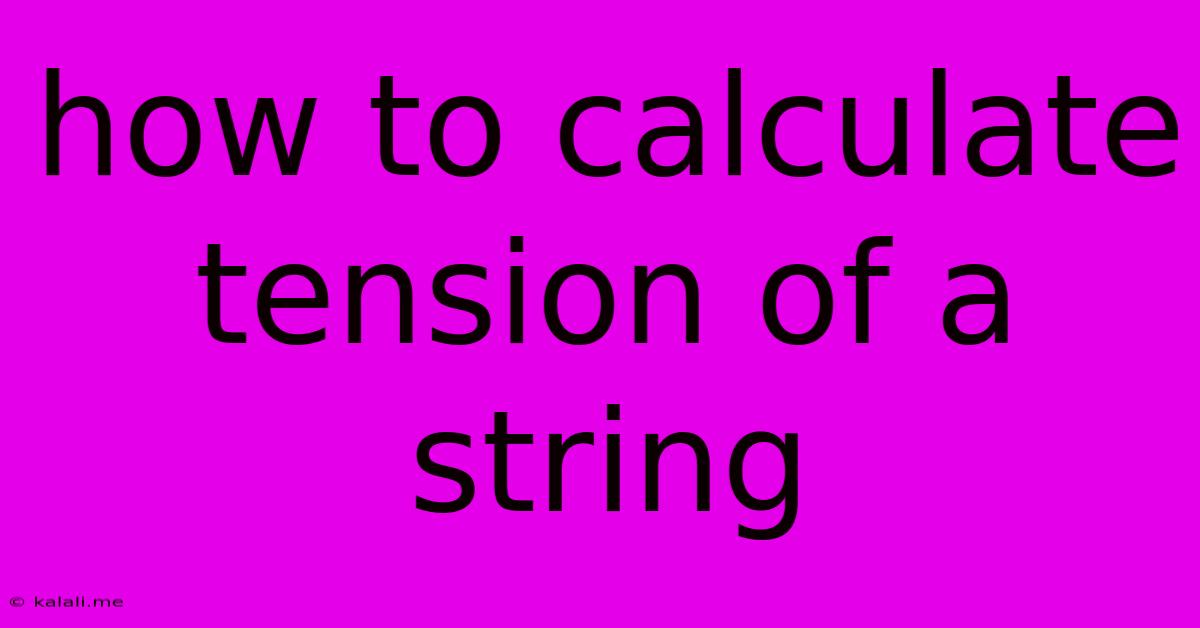How To Calculate Tension Of A String
Kalali
May 22, 2025 · 4 min read

Table of Contents
How to Calculate the Tension of a String: A Comprehensive Guide
Meta Description: Learn how to calculate string tension using various methods, including those involving static equilibrium, Newton's second law, and wave properties. This guide covers different scenarios and provides clear examples.
Calculating the tension in a string is a fundamental concept in physics with applications ranging from simple mechanics to advanced wave phenomena. The approach to calculating tension depends heavily on the system involved. This guide will walk you through several common scenarios and provide you with the necessary formulas and steps.
Understanding Tension
Tension is the force transmitted through a string, rope, cable, or similar one-dimensional continuous object, when it is pulled tight by forces acting from opposite ends. The tension force is directed along the length of the string and pulls equally on the objects at both ends. Understanding this directional force is key to solving tension problems.
Methods for Calculating String Tension
Several methods exist for calculating string tension, depending on the specifics of the problem:
1. Static Equilibrium:
This method applies when the string is stationary and the net force acting on it is zero. This means the forces acting on the string are balanced. We utilize Newton's First Law: ΣF = 0 (the sum of all forces equals zero).
-
Scenario: A mass hanging from a single string.
-
Calculation: The tension in the string is equal to the weight of the mass (T = mg), where 'm' is the mass and 'g' is the acceleration due to gravity (approximately 9.8 m/s²).
-
Example: A 2 kg mass hangs from a string. The tension in the string is T = (2 kg)(9.8 m/s²) = 19.6 N.
2. Newton's Second Law (Dynamics):
This method is applied when the string is accelerating. Here we use Newton's Second Law: ΣF = ma (the sum of all forces equals mass times acceleration).
-
Scenario: A mass is being pulled upwards with an accelerating force.
-
Calculation: The tension will be greater than the weight of the mass. The net force is the difference between the tension and the weight, which equals the mass times acceleration. Therefore, T - mg = ma, and thus T = m(g + a).
-
Example: A 1 kg mass is accelerated upwards at 2 m/s². The tension is T = (1 kg)(9.8 m/s² + 2 m/s²) = 11.8 N. Note that if the mass were accelerating downwards, 'a' would be negative.
3. Systems with Multiple Strings and Angles:
In systems with multiple strings at angles, we need to resolve the forces into their components (typically x and y components).
-
Scenario: A mass is suspended by two strings at different angles.
-
Calculation: We use vector addition and the equilibrium condition (ΣFx = 0 and ΣFy = 0). This often involves trigonometry to resolve the tension forces into their horizontal and vertical components.
-
Example: This type of problem requires a diagram and careful application of trigonometry, making a generalized formula impractical. The process involves setting up separate equations for the horizontal and vertical components of the forces and solving them simultaneously.
4. Wave Properties:
Tension also plays a crucial role in determining the speed of waves traveling along a string. The speed (v) of a transverse wave on a string is related to the tension (T) and the linear mass density (μ) of the string by the equation:
v = √(T/μ)
Where μ = m/L (mass per unit length). This equation can be rearranged to solve for T if the wave speed and linear mass density are known.
Important Considerations:
-
Mass of the String: In many basic problems, the mass of the string itself is negligible compared to the masses involved. However, in scenarios involving very long or heavy strings, the mass of the string must be considered in the calculations.
-
Friction: Friction can significantly impact tension calculations, especially in pulley systems or situations involving significant contact between the string and other surfaces.
Calculating string tension requires a good understanding of forces, Newton's laws, and in some cases, wave phenomena. By carefully analyzing the system and applying the appropriate equations, you can accurately determine the tension in a string under various conditions. Remember to always draw a free-body diagram to visualize the forces acting on the string and the objects connected to it. This will significantly aid in setting up the correct equations for your problem.
Latest Posts
Latest Posts
-
Sign Someone Up For Junk Email
May 22, 2025
-
Is Throwing A Drink At Someone Assault
May 22, 2025
-
Extra Long Washing Machine Waste Hose
May 22, 2025
-
Is Brake Fluid And Power Steering Fluid The Same
May 22, 2025
-
Car Wont Start With Jumper Leads
May 22, 2025
Related Post
Thank you for visiting our website which covers about How To Calculate Tension Of A String . We hope the information provided has been useful to you. Feel free to contact us if you have any questions or need further assistance. See you next time and don't miss to bookmark.